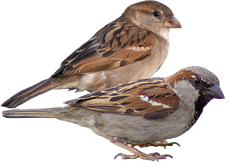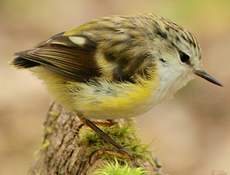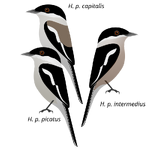mNo edit summary Tag: sourceedit |
mNo edit summary Tag: sourceedit |
||
| Line 142: | Line 142: | ||
{{Project Bird Orders}} |
{{Project Bird Orders}} |
||
{{Project Bird Taxonomy}} |
{{Project Bird Taxonomy}} |
||
| + | [[Category:Neognathae|*{{PN}}]] |
||
| + | [[Category:Neoaves|*{{PN}}]] |
||
| + | [[Category:Passerea|*{{PN}}]] |
||
| + | [[Category:Telluraves|*{{PN}}]] |
||
| + | [[Category:Australaves|*{{PN}}]] |
||
| + | [[Category:Eufalconimorphae|*{{PN}}]] |
||
| + | [[Category:Psittacopasserae|*{{PN}}]] |
||
[[Category:Passeriformes| ]] |
[[Category:Passeriformes| ]] |
||
[[Category:Passerines| ]] |
[[Category:Passerines| ]] |
||
| + | |||
| + | [[Category:Orders of birds]] |
||
Revision as of 19:17, 11 August 2017
| Passerines Temporal range: Early Eocene (Wangerripian) to Recent | |
|---|---|

| |
| House Sparrow (Passer domesticus), a eupasserine and oscine. | |

| |
| Rifleman, Acanthisitta chloris, an Acanthisitti passerine. | |
| Scientific classification | |
| Kingdom: | Animalia |
| Phylum: | Chordata |
| Class: | Aves |
| Clade: | Inopinaves |
| Clade: | Psittacopasserae |
| Order: | Passeriformes Linnaeus, 1758 |
| Type species | |
| Fringilla domestica Linnaeus, 1758 | |
| Groups | |
| Diversity | |
| Roughly 100 families, around 5,400 species | |
A passerine is a bird of the order Passeriformes, which includes more than half of all bird species. Sometimes known as perching birds or, less accurately, as songbirds, the passerines form one of the most diverse terrestrial vertebrate orders: with over 5,000 identified species,[1] it has roughly twice as many species as the largest of the mammal orders, the Rodentia. It contains over 110 families, the second most of any order of vertebrates (after the Perciformes).
Together with parrots, cockatoos, falcons and caracaras and seriemas; they form the clade Australaves.
The names "passerines" and "Passeriformes" are derived from Passer domesticus, the scientific name of the type species—the House Sparrow—and ultimately from the Latin term passer for Passer sparrows and similar small birds.
Characteristics
The order is divided into three suborders, Tyranni (suboscines), Passeri (oscines), and the basal Acanthisitti. Oscines have the best control of their syrinx muscles among birds, producing a wide range of songs and other vocalizations (though some of them, such as the crows, do not sound musical to human beings); some such as the lyrebird are accomplished imitators. The Acanthisittids or New Zealand wrens are tiny birds restricted to New Zealand, at least in modern times; they were long placed in Passeri; their taxonomic position is uncertain, though they seem to be a distinct and very ancient group.
Most passerines are smaller than typical members of other avian orders. The heaviest and altogether largest passerines are the Thick-billed Raven and the larger races of Common Raven, each exceeding 1.5 kg (3.3 lb) and 70 cm (28 in). The Superb Lyrebird and some birds-of-paradise, to 110 cm (43 in) due to very long tails or tail coverts, are longer overall.[verification needed] The smallest passerine is the Short-tailed Pygmy-Tyrant, at 6.5 cm (2.6 in) and 4.2 g (0.15 oz).
Pterylosis or the feather tracts in a typical passerine
The foot of a passerine has three toes directed forward and one toe directed backwards, called anisodactyl arrangement. This arrangement enables the passerine birds to perch upon vertical surfaces, such as trees and cliffs. The toes have no webbing or joining, but in some cotingas the second and third toes are united at their basal third. The hind toe joins the leg at the same level as the front toes. In other orders of birds the toe arrangement is different. The leg muscle of passerine birds contains a special adaption for perching. It will automatically tighten and become stiff, if the bird starts to lose hold of the branch on which it is perching. This enables passerine to sleep while perching without falling off. This is especially useful for passerine birds that develop nocturnal lifestyles.[2]
Most passerine birds develop twelve tail feathers, though the Superb Lyrebird has sixteen.[citation needed] Certain species of passerines have stiff tail feathers, which help the birds balance themselves when perching upon vertical surfaces.
The chicks of passerines are altricial; blind, featherless, and helpless when hatched from their eggs. This requires that the chicks receive a lot of parental care. Most passerines lay coloured eggs, in contrast with non-passerines, most of whose eggs are white except in some ground-nesting groups such as Charadriiformes and nightjars, where camouflage is necessary, and some parasitic cuckoos, which match the passerine host's egg.
Origin and evolution
The evolutionary history of the passerine families and the relationships among them remained rather mysterious until the late 20th century. In many cases, passerine families were grouped together on the basis of morphological similarities which, it is now believed, are the result of convergent evolution, not a close genetic relationship. For example, the "wrens" of the northern hemisphere, those of Australia, and those of New Zealand look very similar and behave in similar ways, and yet belong to three far-flung branches of the passerine family tree; they are as unrelated as it is possible to be while remaining Passeriformes.[3]
Much research remains to be done, but advances in molecular biology and improved paleobiogeographical data are gradually revealing a clearer picture of passerine origins and evolution that reconciles molecular affinities, the constraints of morphology and the specifics of the fossil record.[4] It is now thought that the first passerines evolved in Gondwana at some time in the Paleogene, maybe around the Late Paleocene some 60–55 mya.[5] The initial split was between the Tyranni, the songbirds, the Eurylaimides and the New Zealand "wrens", which must have diverged during a short period of time (some million years at most). The Passeriformes apparently evolved out of a fairly close-knit clade of "near passerines" which contains such birds as the Piciformes and Coraciiformes.[6]
A little later, a great radiation of forms took place out of Australia-New Guinea: the Passeri or songbirds. A major branch of the Passeri, "Parvorder Passerida", emerged either as the sister group to the basal lineages and corvoids ("Parvorder Corvida"), or more likely as a subgroup of it, and expanded deep into Eurasia and Africa, where there was a further explosive radiation of new lineages. This eventually led to three major passeridan lineages comprising about 4,000 species, which in addition to the corvoidan clade and numerous minor lineages make up songbird diversity today. There has been extensive biogeographical mixing, with northern forms returning to the south, southern forms moving north, and so on.
Fossil record
Earliest passerines
Perching bird osteology, especially of the limb bones, is rather diagnostic.[7] However, the early fossil record is poor because the first Passeriformes were apparently on the small side of the present size range, and their delicate bones did not preserve well. QM specimens F20688 (carpometacarpus) and F24685 (tibiotarsus) from Murgon, Queensland are fossil bone fragments clearly recognizable as passeriform; they represent two species of approximately 10 and 20 cm in overall length and prove that some 55 mya, barely into the Early Eocene, early perching birds were recognizably distinct.[8]
Male Superb Lyrebird (Menura novaehollandiae). This very primitive songbird shows strong sexual dimorphism, with a peculiarly apomorphic display plumage in males.
A quite similar group, the Zygodactylidae (named for their zygodactylous approach to perching) independently arose at much the same time – and possibly from closely related ancestors – in the landmasses bordering the North Atlantic, which at that time was only some two-thirds of its present width.
Until the discovery of the Australian fossils Palaeospiza bella from the Priabonian Florissant Fossil Beds (Late Eocene, around 35 mya) was the oldest known passeriform. However, it is now considered a non-passeriform near passerine.
From the Bathans Formation at the Manuherikia River in Otago, New Zealand, MNZ S42815 (a distal right tarsometatarsus of a Tui-sized bird) and several bones of at least one species of Saddleback-sized bird have recently been described. These date from the Early to Middle Miocene (Awamoan to Lillburnian, 19-16 mya).[9]
Modern knowledge about the living passerines' interrelationships (see the list of families below) suggests that the last common ancestor of all living Passeriformes was a small forest bird, probably with a stubby tail[10] and an overall drab coloration, but possibly with marked sexual dimorphism. The latter trait seems to have been lost and re-evolved multiple times in songbird evolution alone, judging from its distribution among the extant lineages. Sexual dichromatism is very rare among the basal lineages of Passerida, and probably their plesiomorphic condition. But among the youngest passerid clade, the Passeroidea, extremely colorful males and drab females are common, if not the rule. On the other hand, among the basalmost Passeri there are a considerable number of strongly dimorphic lineages too, such as the very ancient Menuridae as well as many Meliphagoidea and Corvoidea. Sexual dimorphism is also not uncommon in the Acanthisittidae and prominent in some suboscines such as the Pipridae and Cotingidae.
Early European passerines
In Europe, perching birds are not too uncommon in the fossil record from the Oligocene onwards, but most are too fragmentary for a more definite placement:
- Wieslochia (Early Oligocene of Frauenweiler, Germany)
- Passeriformes gen. et sp. indet. (Early Oligocene of Luberon, France) – suboscine or basal[11]
- Passeriformes gen. et spp. indet. (Late Oligocene of France) – several suboscine and oscine taxa[12]
- Passeriformes gen. et spp. indet. (Middle Miocene of France and Germany) – basal?[13]
- Passeriformes gen. et spp. indet. (Sajóvölgyi Middle Miocene of Mátraszõlõs, Hungary) – at least 2 taxa, possibly 3; at least one probably Oscines[14]
- Passeriformes gen. et sp. indet. (Middle Miocene of Felsõtárkány, Hungary) – oscine?[15]
- Passeriformes gen. et sp. indet. (Late Miocene of Polgárdi, Hungary) – Sylvioidea (Sylviidae? Cettiidae?)[16]
Wieslochia was possibly not a member of any extant suborder. That not only the Passeri expanded much beyond their region of origin is proven by an undetermined broadbill (Eurylaimidae) from the Early Miocene (roughly 20 mya) of Wintershof, Germany, and the indeterminate Late Oligocene suboscine from France listed above. Even very basal Passeriformes might have been common in Europe until the Middle Miocene, some 12 mya.[17] Extant Passeri superfamilies were quite distinct by that time and are known since about 12–13 mya when modern genera were present in the corvoidean and basal songbirds. The modern diversity of Passerida genera is known mostly from the Late Miocene onwards and into the Pliocene (about 10–2 mya). Pleistocene and early Holocene lagerstätten (<1.8 mya) yield numerous extant species, and many yield almost nothing but extant species or their chronospecies and paleosubspecies.
American fossils
In the Americas, the fossil record is more scant before the Pleistocene, from which several still-existing suboscine families are documented. Apart from the indeterminable MACN-SC-1411 (Pinturas Early/Middle Miocene of Santa Cruz Province, Argentina),[18] an extinct lineage of perching birds has been described from the Late Miocene of California, USA: the Palaeoscinidae with the single genus Paleoscinis. "Palaeostruthus" eurius (Pliocene of Florida) probably belongs to an extant family, most likely passeroidean.
- See also Late Quaternary prehistoric birds.
Systematics and taxonomy
Initially,[citation needed] the Corvida and Passerida were classified as "parvorders" in the suborder Passeri; in accord with the usual taxonomic practice, they would probably be ranked as infraorders. As originally envisioned in the Sibley-Ahlquist taxonomy, they contained, respectively, the large superfamilies Corvoidea and Meliphagoidea as well as minor lineages, and the superfamilies Sylvioidea, Muscicapoidea and Passeroidea.
The peculiar Bearded Reedling, Panurus biarmicus, may be the most enigmatic passerine. No truly close relatives have been identified.
This arrangement has been found to be overly simplified by more recent research. Since the mid 2000s, literally dozens of studies are being published which try rather successfully to resolve the phylogeny of the passeriform radiation. For example, the Corvida in the traditional sense were a rather arbitrary assemblage of early and/or minor lineages of passeriform birds of Old World origin, generally from the region of Australia, New Zealand, and Wallacea. The Passeri on the other hand can be made monophyletic by moving some families about, but the "clean" three-superfamily-arrangement has turned out to be far more complex and it is uncertain whether future authors will stick to it.
Major "wastebin" families such as the Old World warblers and Old World babblers have turned out to be paraphyletic and are being rearranged. Several taxa turned out to represent highly distinct species-poor lineages and consequently new families had to be established, some of them – like the Stitchbird of New Zealand and the Eurasian Bearded Reedling – monotypic with only one living species.[19] It seems likely that in the Passeri alone, a number of minor lineages will eventually be recognized as distinct superfamilies. For example, the kinglets constitute a single genus with less than 10 species today, but seem to have been among the first perching bird lineages to diverge as the group spread across Eurasia. No particularly close relatives of them have been found among comprehensive studies of the living Passeri, though it is suspected that they might be fairly close to some little-studied tropical Asian groups. Treatment of the nuthatches, wrens, and their closest relatives as a distinct superfamily Certhioidea is increasingly considered justified; the same might eventually apply to the tits and their closest relatives.
This process is still continuing. Therefore, the arrangement as presented here is subject to change. However, it should take precedence over unreferenced conflicting treatments in family, genus and species articles here; see the next section for default sources.
Taxonomic list of Passeriformes families
- Main article: List of passerines
Footnotes
- ^ Ernst Mayr, "The Number of Species of Birds", The Auk, Volume 63, Number 1 (January, 1946), p.67
- ^ Rebecca Stefoff(2008), "The Bird Class", Marshall Cavendish Benchmark
- ^ The name wren has been applied to other, unrelated birds in Australia and New Zealand. The 27 Australasian "wren" species in the family Maluridae are unrelated, as are the New Zealand wrens in the family Acanthisittidae, the antwrens in the family Thamnophilidae, and the wren-babblers of the family Timaliidae. For the monophyly of the "true wrens", Troglodytidae, see F.K. Barker, "Monophyly and relationships of wrens (Aves: Troglodytidae): a congruence analysis of heterogeneous mitochondrial and nuclear DNA sequence data", Molecular phylogenetics and evolution, 2004
- ^ The context is summarised in Gareth J. Dyke and Marcel van Tuinen, "The evolutionary radiation of modern birds (Neornithes): reconciling molecules, morphology and the fossil record", Zoological Journal of the Linnean Society 141.2 (June 2004:153–177)
- ^ L. Christidis, A. Cooper, M. Irestedt, et al., "A Gondwanan origin of passerine birds supported by DNA sequences of the endemic New Zealand wrens" Proceedings of the Royal Society B, February 2002:235–241.
- ^ Johansson & Ericson (2003);
- ^ See e.g. Boles (1997), Manegold et al. (2004), Mayr & Manegold (2006)
- ^ Boles (1997)
- ^ Worthy et al. (2007)
- ^ The last common ancestor of all songbirds most likely had a decidedly longer tail. See del Hoyo et al. (2003, 2004).
- ^ Specimen SMF Av 504. A flattened right hand of a passerine perhaps 10 cm long overall. If suboscine, perhaps closer to Cotingidae than to Eurylaimides: Roux (2002), Mayr & Manegold (2006)
- ^ Huguenet et al. (2003), Mayr & Manegold (2006)
- ^ Specimens SMF Av 487–496; SMNS 86822, 86825-86826; MNHN SA 1259–1263: tibiotarsus remains of small, possibly basal Passeriformes: Manegold et al. (2004)
- ^ A partial coracoid of a probable Muscicapoidea, possibly Turdidae; distal tibiotarsus and tarsometatarsus of a smallish to mid-sized passerine which may be the same as the preceding; proximal ulna and tarsometatarsus of a Paridae-sized passerine: Gál et al. (1998–1999, 2000)
- ^ A humerus diaphysis piece of a swallow-sized passerine: Hír et al. (2001)
- ^ Hír et al. (2001)
- ^ Manegold et al. (2004)
- ^ Distal right humerus, possibly suboscine: Noriega & Chiappe (1991, 1993)
- ^ The former does not even have recognized subspecies, while the latter is one of the most singular birds alive today. Good photos of a Bearded Reedling are for example here and here.
References
| Look up http://en.wiktionary.org/wiki/Passerine in Wiktionary, the free dictionary. |
| Wikimedia Commons has media related to: http://commons.wikimedia.org/wiki/Category:Passeriformes |
- Alström, Per; Ericson, Per G.P.; Olsson, Urban & Sundberg, Per (2006): Phylogeny and classification of the avian superfamily Sylvioidea. Mol. Phylogenet. Evol. '38'(2): 381–397. doi:10.1016/j.ympev.2005.05.015
- Barker, F. Keith; Barrowclough, George F. & Groth, Jeff G. (2002): A phylogenetic hypothesis for passerine birds: taxonomic and biogeographic implications of an analysis of nuclear DNA sequence data. Proc. R. Soc. B '269'(1488): 295–308. doi:10.1098/rspb.2001.1883 PDF fulltext
- Barker, F. Keith; Cibois, Alice; Schikler, Peter A.; Feinstein, Julie & Cracraft, Joel (2004): Phylogeny and diversification of the largest avian radiation. PNAS '101'(30): 11040-11045. doi:10.1073/pnas.0401892101 PDF fulltext Supporting information
- Beresford, P.; Barker, F.K.; Ryan, P.G. & Crowe, T.M. (2005): African endemics span the tree of songbirds (Passeri): molecular systematics of several evolutionary 'enigmas'. Proc. Roy. Soc. Lond. B '272'(1565): 849–858. doi:10.1098/rspb.2004.2997 PDF fulltext Electronic appendix
- Boles, Walter E. (1997): Fossil Songbirds (Passeriformes) from the Early Eocene of Australia. Emu '97'(1): 43–50. doi:10.1071/MU97004
- Cibois, Alice; Slikas, Beth; Schulenberg, Thomas S. & Pasquet, Eric (2001): An endemic radiation of Malagasy songbirds is revealed by mitochondrial DNA sequence data. Evolution '55'(6): 1198–1206. DOI:10.1554/0014-3820(2001)055[1198:AEROMS]2.0.CO;2 PDF fulltext
- del Hoyo, J.; Elliot, A. & Christie, D. (eds.) (2003): Handbook of the Birds of the World (Vol. 8: Broadbills to Tapaculos). Lynx Edicions. ISBN 8487334504
- del Hoyo, J.; Elliot, A. & Christie, D. (eds.) (2004): Handbook of the Birds of the World (Vol. 9: Cotingas to Pipits and Wagtails. Lynx Edicions). ISBN 8487334695
- del Hoyo, J.; Elliot, A. & Christie, D. (eds.) (2005): Handbook of the Birds of the World (Vol. 10: Cuckoo-Shrikes to Thrushes. Lynx Edicions). ISBN 8487334725
- del Hoyo, J.; Elliot, A. & Christie, D. (eds.) (2006): Handbook of the Birds of the World (Vol. 11: Old World Flycatchers to Old World Warblers). Lynx Edicions. ISBN 849655306X
- del Hoyo, J.; Elliot, A. & Christie, D. (eds.) (2007): Handbook of the Birds of the World (Vol. 12: Picathartes to Tits and Chickadees). Lynx Edicions. ISBN 9788496553422
- Dickinson, E.C. (ed.) (2003): The Howard and Moore complete checklist of the birds of the World (3rd edition). Christopher Helm, London. ISBN 071366536X
- Ericson, Per G.P. & Johansson, Ulf S. (2003): Phylogeny of Passerida (Aves: Passeriformes) based on nuclear and mitochondrial sequence data. Mol. Phylogenet. Evol. '29'(1): 126–138 doi:10.1016/S1055-7903(03)00067-8 PDF fulltext
- Gál, Erika; Hír, János; Kessler, Eugén & Kókay, József (1998–99): Középsõ-miocén õsmaradványok, a Mátraszõlõs, Rákóczi-kápolna alatti útbevágásból. I. A Mátraszõlõs 1. lelõhely [Middle Miocene fossils from the sections at the Rákóczi chapel at Mátraszőlős. Locality Mátraszõlõs I.]. Folia Historico Naturalia Musei Matraensis '23': 33–78. [Hungarian with English abstract] PDF fulltext
- Gál, Erika; Hír, János; Kessler, Eugén, Kókay, József & Márton, Venczel (2000): Középsõ-miocén õsmaradványok a Mátraszõlõs, Rákóczi-kápolna alatti útbevágásból II. A Mátraszõlõs 2. lelõhely [Middle Miocene fossils from the section of the road at the Rákóczi Chapel, Mátraszõlõs. II. Locality Mátraszõlõs 2]. Folia Historico Naturalia Musei Matraensis '24': 39–75. [Hungarian with English abstract] PDF fulltext
- Hír, János; Kókay, József; Venczel, Márton; Gál, Erika & GKessler, Eugén (2001): Elõzetes beszámoló a felsõtárkányi "Güdör-kert" n. õslénytani lelõhelykomplex újravizsgálatáról [A preliminary report on the revised investigation of the paleontological locality-complex "Güdör-kert" at Felsõtárkány, Northern Hungary)] Folia Historico Naturalia Musei Matraensis '25': 41–64 [Hungarian with English abstract]. PDF fulltext
- Hugueney, Marguerite; Berthet, Didier; Bodergat, Anne-Marie; Escuillié, François; Mourer-Chauviré, Cécile & Wattinne, Aurélia (2003): La limite Oligocène-Miocène en Limagne: changements fauniques chez les mammifères, oiseaux et ostracodes des différents niveaux de Billy-Créchy (Allier, France) [The Oligocene-Miocene boundary in Limagne: faunal changes in the mammals, birds and ostracods from the different levels of Billy-Créchy (Allier, France)] [French with English abstract]. Geobios '36'(6): 719–731. doi:10.1016/j.geobios.2003.01.002 (HTML abstract)
- Johansson, Ulf S. & Ericson, Per G.P. (2003): Molecular support for a sister group relationship between Pici and Galbulae (Piciformes sensu Wetmore 1960). J. Avian Biol. '34'(2): 185–197. doi:10.1034/j.1600-048X.2003.03103.x PDF fulltext
- Jønsson, Knud A. & Fjeldså, Jon (2006): A phylogenetic supertree of oscine passerine birds (Aves: Passeri). Zool. Scripta '35'(2): 149–186. doi:10.1111/j.1463-6409.2006.00221.x (HTML abstract)
- Lovette, Irby J.& Bermingham, Eldredge (2000): c-mos Variation in Songbirds: Molecular Evolution, Phylogenetic Implications, and Comparisons with Mitochondrial Differentiation. Mol. Biol. Evol. '17'(10): 1569–1577. PDF fulltext
- Mayr, Gerald & Manegold, Albrecht (2006): A Small Suboscine-like Passeriform Bird from the Early Oligocene of France. Condor '108'(3): 717–720. [English with Spanish abstract] DOI:10.1650/0010-5422(2006)108[717:ASSPBF]2.0.CO;2 HTML abstract
- Manegold, Albrecht; Mayr, Gerald & Mourer-Chauviré, Cécile (2004): Miocene Songbirds and the Composition of the European Passeriform Avifauna. Auk '121'(4): 1155–1160. [English with Spanish abstract] DOI:10.1642/0004-8038(2004)121[1155:MSATCO]2.0.CO;2 Imageless HTML fulltext
- Noriega, Jorge I. & Chiappe, Luis M. (1991): El más antiguo Passeriformes de America del Sur. Presentation at VIII Journadas Argentinas de Paleontologia de Vertebrados ["The most ancient passerine from South America"]. [Spanish] Abstract in Ameghiniana '28'(3–4): 410. Google Books fulltext
- Noriega, Jorge I. & Chiappe, Luis M. (1993): An Early Miocene Passeriform from Argentina. Auk '110'(4): 936–938. PDF fulltext DjVu fulltext
- Roux, T. (2002): Deux fossiles d'oiseaux de l'Oligocène inférieur du Luberon ["Two bird fossils from the Lower Oligocene of Luberon"]. [French[verification needed]] Courrier Scientifique du Parc Naturel Régional du Luberon '6': 38–57.
- Worthy, Trevor H.; Tennyson, A.J.D.; Jones, C.; McNamara, J.A. & Douglas, B.J. (2007): Miocene waterfowl and other birds from central Otago, New Zealand. J. Syst. Palaeontol. '5'(1): 1–39. doi:10.1017/S1477201906001957 (HTML abstract)
}}
| below = • Category • Portal • Outline }}

|
This article is part of Project Bird Orders, a All Birds project that aims to write comprehensive articles on each bird order, including made-up orders. |

|
This article is part of Project Bird Taxonomy, a All Birds project that aims to write comprehensive articles on every order, family and other taxonomic rank related to birds. |
